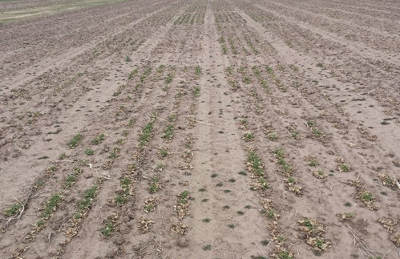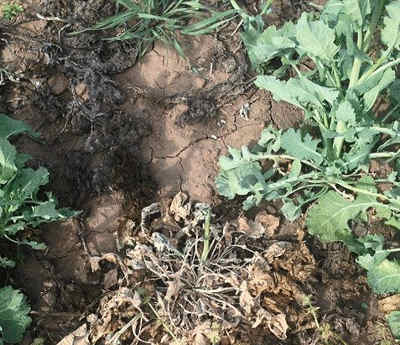The 2017-2018 growing season has been a challenging one as the winter hardiness of canola has been tested across Kansas. Much of the canola crop is flowering but development is delayed by colder-than-normal April temperatures and the current drought. Fields that were planted on time and were able to establish a good stand last fall are faring well despite these conditions. Other fields that did not establish a good stand are seeing moderate to severe winterkill. What ultimately causes winterkill in canola is an interaction of the environment, variety, and management practices of the producer. Any time we see winterkill in canola, it is important to examine the circumstances that led to the stand losses.
The 2017-2018 growing season
To understand what has been observed in some fields in Kansas, we need to remember what establishment conditions were like last September. For a large portion of the state, soil moisture was lacking during the optimum planting window and thus many producers waited for rain to begin planting their canola. Soil moisture didn’t improve until late September/early October which is pushing the end of the planting window.
Initially, the planting delay wasn’t a cause for major concern because the outlook was for warmer-than-normal temperatures. In a way, experiences over previous growing seasons made us accustomed to warm fall temperatures. Thus, even though planting was delayed, we were expecting to achieve adequate growth (6-10 true leaves and 8-12 inches of top growth) to sustain the plants through the winter. Nonetheless, a cold snap in mid-October and dry fall conditions shut the crop down early and plant growth didn’t resume as expected. Unless producers were able to plant earlier in the optimum window, many fields were headed for winter with less than adequate top growth.
Winterkill has been observed in research trials and producers’ fields from the Nebraska border to the Oklahoma border in Kansas. Varietal differences are being observed. Fields planted just a couple miles from each other have shown dramatic variation in survival. Not all fields have been affected; some fields will see no impacts from winter stand losses. What ultimately is causing winterkill this season is low temperatures (nearing -10 degrees F in some instances) and drought, coupled with the lack of fall growth. Today’s top-rated varieties for winter survival are able to withstand extremely low temperatures, but the confounding factors of drought and small plants are not helping the situation (Figure 1).

Figure 1. Differential winterkill was observed at the North Central Experiment Field west of Belleville. Although some varieties showed acceptable survival, the plot was abandoned because of too much variability between replications. Photo by Mike Stamm, K-State Research and Extension.
Cold temperatures can also have unseen negative consequences on crop growth and development. Freezing and thawing cause cracking in the crown or root, allowing fungi to enter that create root decay. Plants may appear to regrow normally in the spring, but after some time, the severely damaged plants will wilt, turn bluish-gray, and eventually die (Figure 2). We are starting to see this occur in a few fields and research plots. Other plants may continue to grow normally and never show any signs of damage.

Figure 2. Spring stand loss caused by severe crown damage over the winter. Photo by Scott Dooley, K-State Research and Extension.
The 2017-2018 season versus previous seasons
As stated previously, winter survival is a complex trait that can be influenced by many factors. Looking back at the recent history of canola production across Kansas, winterkill has been caused by different weather patterns. In recent years, we have observed winterkill caused by:
- Bitterly cold temperatures for extended periods of time (2013-2014)
- Extreme temperature fluctuations on an inadequately cold-acclimated crop (2014-2015)
- Too much fall growth causing severe crown and stem damage as cold temperatures set in (2016-2017)
The causes of winterkill this season are similar to that of the 2013-2014.